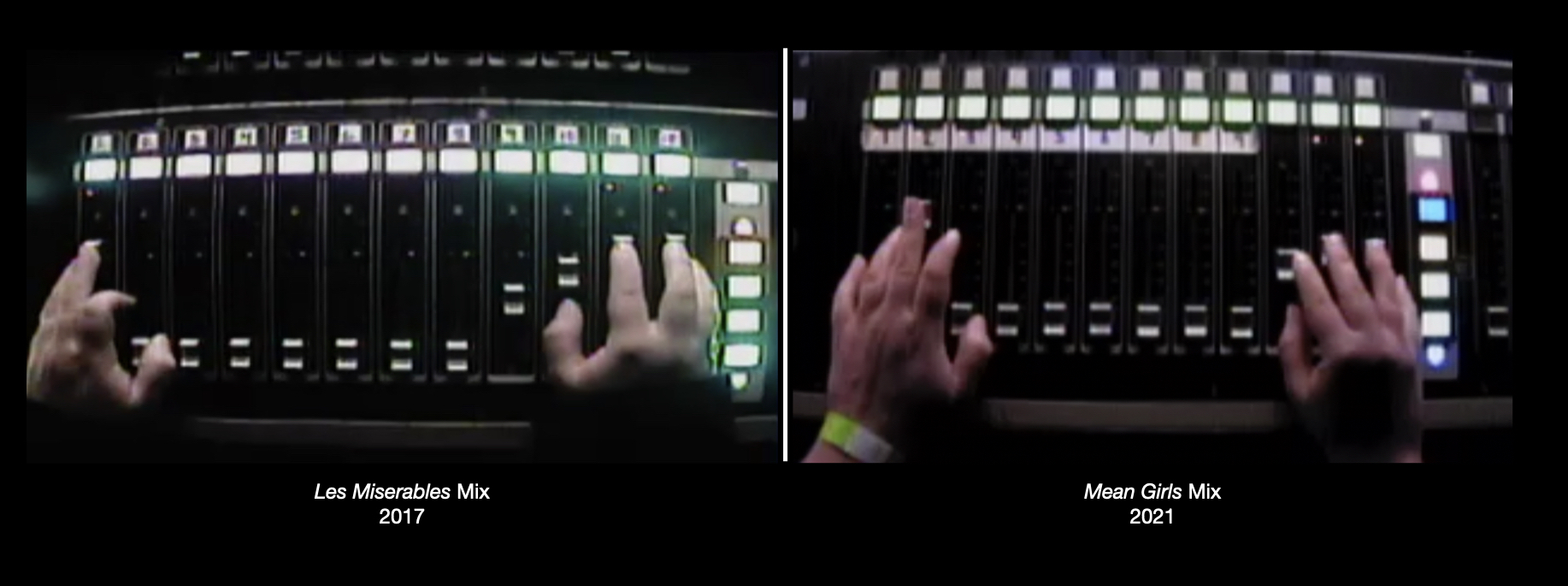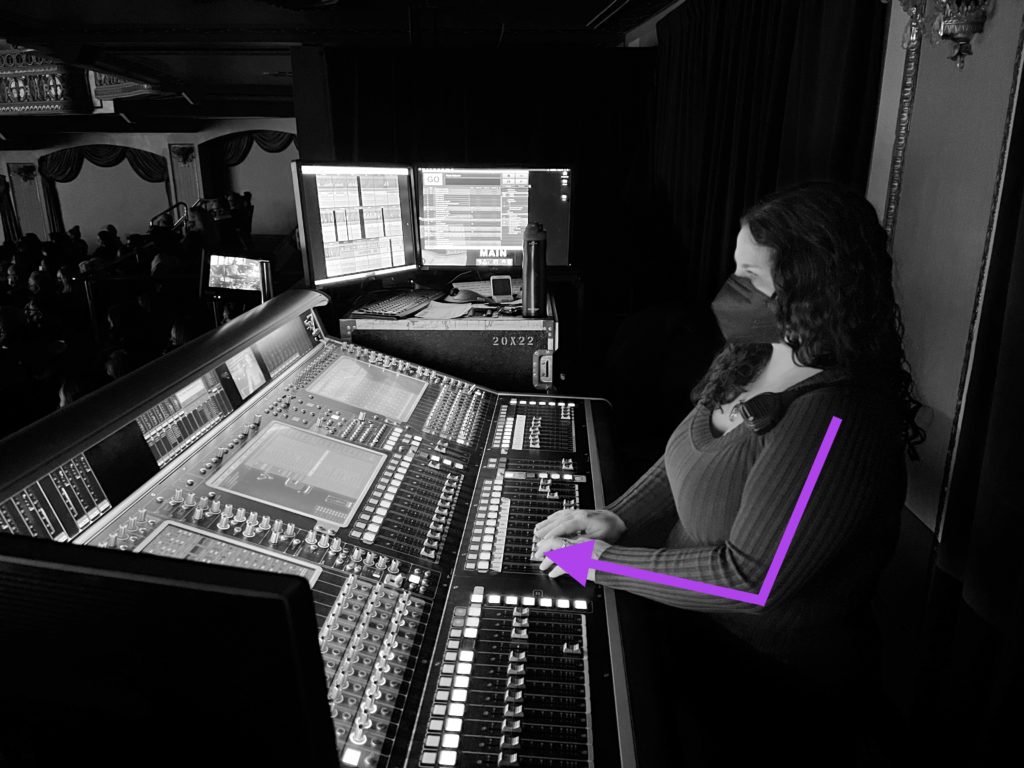Mixing is an active experience
Anyone who’s watched me mix a show knows that I’m never standing still. I’m usually tapping my toes or bopping my head to the music while timing my fader throws. I’m constantly shifting my focus as I look up at the stage, down at my hands, or at the monitors on either side of me. I’m listening so my fingers can respond to the actors or musicians while keeping a thought on what’s coming up next. The actual mixing might happen in a small footprint, but there’s a lot going on. It helps to have a solid physical foundation to make your day-to-day life easier especially as so much of our job requires repetitive motion, which can take a toll on our bodies.
The first thing to look at is how you stand or sit at the console
If you’re sitting, it makes it easier because you can adjust your chair to the right height every time and call it good. Personally, I prefer to stand: it keeps me more alert and focused, especially when I’m on a show for months or years. Also, I’m short, so it’s easier for me to reach the top of the other fader banks of the console if I’m standing rather than having to get out of my chair or slide it any time I want to make an adjustment. If you prefer to stand as well, do yourself a favor and get an anti-fatigue mat. The floors at FOH can be anywhere from concrete to carpet to plywood, and it pays down the road to be nice to your knees now.
However, standing at the console can present a challenge if people mixing the same show are at different heights. If you’re short, you can stand on a case lid or apple box. If you’re tall, you can lift the console up with wooden blocks, or (if you already know when you’re in the shop) get racks that are taller and can make the board higher. Personally, I know that 16 space racks put the console at a good height for me to mix while standing.
In some cases, you might not able to find a good solution, or the console is already set to someone else’s height (if you’re a sub or A2 and the console is already set at a good height for the A1). In these cases, I end up using a chair, even though I’d rather stand. It’s far better to have a proper position and the minor inconvenience of having to get up if you need to make an adjustment than force yourself to mix in an uncomfortable position.
For me, a comfortable position means
That I aim for a console or chair height where my elbows are bent at a relaxed, roughly 90˚ angle so there’s an almost straight line from my elbow through my wrist when my hands are resting on the console, fingers on faders. If you’re too far above the console, your elbow ends up higher than your wrist and you put extra pressure on your joints as you naturally press through your palm with the way the wrist bends. On the other hand, if you’re too far below, your shoulders have to rotate outward to get your hands on top of the console and that puts pressure on your shoulders as well as the wrists.
Any rotation of a joint, even a small amount, can create problems over time. On Les Mis, I used my index and middle fingers to move the two orchestra faders, which is fairly common for most people. However, that rotated my wrist to an awkward angle which put stress on it. Eventually, my forearm muscles started to tighten up from that strain, which made it uncomfortable to mix. Even in the mix videos for that show (recorded after maybe 50-60 shows into the run), there are a couple of times where I have to find breaks to stretch out my hand or roll my wrist to relieve some of the tension. I went to physical therapy and got stretches and exercises to help (if something hurts, always go see a professional in a timely manner), but what actually fixed it was when I realized that I could use my middle and ring fingers for the band faders instead and that would shift my wrist to a better position. This eliminated the cause of the problem itself, and as a side benefit, I had my index finger free to make verb adjustments without having to move my hand off the band faders!
No one mixes the exact same way
So what works for me might not work for you, and that’s okay. I prefer to use my middle fingers as the primary for mixing dialogue, but some people use their index. It takes time and a willingness to experiment to develop what your mixing style looks like.
Here are a few things I’ve found that have helped me as a mixer
I use the heel of my hand as an anchor point while I’m mixing: as my hands have to move back and forth to different faders, that bone at the base of my palm always ends up resting on the same area of the console, just below the faders. From there, I have a general reference for where the fader is without having to look at my hands: I know based on how far my fingers are extended because my hand is always the same distance from the base of the fader. (With any rule, there are always exceptions: sometimes I’ll have to throw further than usual, so I’ll lift up the heel of my hand and use my pinky for additional stability, or a scene might have me jumping around more than usual so I’m not in one place long enough to truly anchor my hand. When it works, use it. If it doesn’t, find something that does.)
If my left hand (usually dialogue) is free, but my right hand (usually band, some vocals, and the button for sound effects, next scene, etc) is in the middle of a band move when I need to take a cue, I’ll cross my left hand over my right to hit the GO button, similar to playing a piano. I’ve gotten skeptical looks from mixers when doing it while I’m training on shows, but it’s something that works for me. It takes a little trial and error to make sure it’s the right choice and I’m not taking my hand off a fader when I really shouldn’t or my right hand actually does have a moment to talk the cue, but when it works, it helps to simplify my mix choreography.
I’ve spent a lot of time tweaking how my script works. While the script itself isn’t a mechanical part of mixing, how you integrate page turns definitely is. As I developed my system for marking and formatting, I made it my mission to condense the script to as few pages as possible and minimize how many times I had to reach up to flip a page. While that is a legitimate strategy, I found that it put my page turns at awkward points in the mix and had me scrambling at times. Over the course of several productions, I found that it worked far better for me to make sure that each page of the script ended on an easy (or as easy as possible) turn, whether that was a pause in the action or splitting a long line up over the end of one page and the beginning of another. This added a few page turns overall but put them at much easier places in my mix.
Something I need to continue to work on is my focus. Once I’ve been on a show for a while and I have the mix down, my mind will want to wander. Another mixer told me she uses yoga and meditation to help improve her concentration and her ability to bring herself back to the present and to the show. I’m slowly improving, but it’s another skill I need to hone, especially after I lost some of that ability while I didn’t have the chance to mix on a regular basis during the Covid hiatus.
However, consistency will help you as you develop better focus. While I obviously encourage being flexible, once you find what works, set a routine. That’s taking a cue on the same beat of a song, or presetting the band on the same word, even when you could do it anywhere in that sentence, or even taking a water break during the same line every show. Just like standing helps keep me focused when my show count-ticks into triple digits, consistency builds a muscle memory that has saved me more than a few times if my concentration slips.
The most important thing is to listen to your body and your instincts. If something hurts or feels uncomfortable, find a way to change your process so you don’t have to do that. If you have an idea for something that might streamline things, try it. The worst thing that happens is you go back to what was working just fine before and try the next idea when it comes along.

